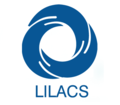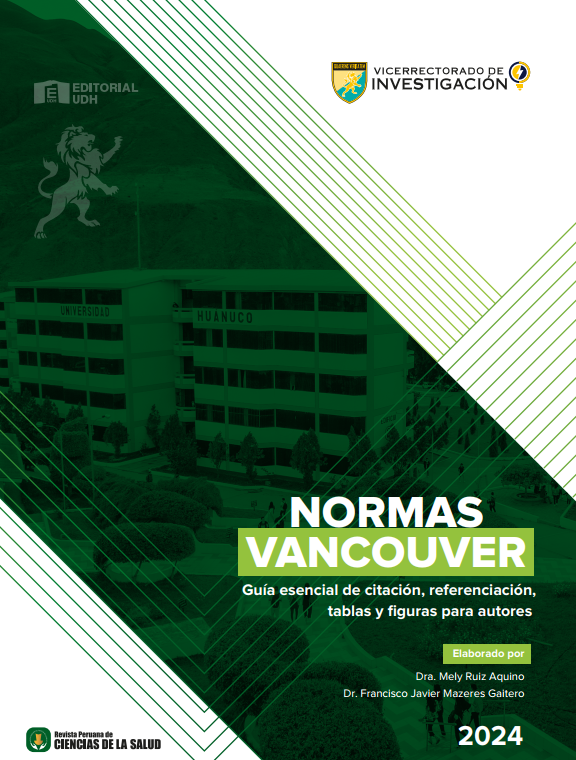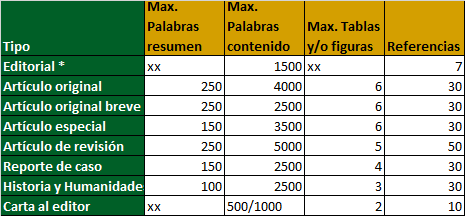Anemia y síntomas de depresión en pacientes con cáncer de mama temprano en el Instituto Nacional de Enfermedades Neoplásicas, Lima, Perú
DOI:
https://doi.org/10.37711/rpcs.2022.4.3.377Palabras clave:
anemia, cáncer de mama, depresión, diagnóstico, morbilidad, mortalidadResumen
Objetivo. Determinar la relación entre la anemia y los síntomas de depresión en las pacientes con cáncer de mama en etapa temprana en el Instituto Nacional de Enfermedades Neoplásicas (INEN), Lima, Perú. Métodos. Se realizó un estudio observacional transversal analítico de 60 mujeres peruanas diagnosticadas con cáncer de mama en etapa temprana, estadios I y II, entre junio de 2019 y marzo de 2020. Todas las participantes fueron evaluadas por el puntaje del Inventario de depresión de Beck-II (BDI-II), no habían recibido quimioterapia previa y cumplían con los criterios de inclusión. Cada participante aportó una muestra de sangre que se utilizó para estimar la hemoglobina y el recuento de glóbulos rojos y blancos. Resultados. De las 60 pacientes que cumplieron los criterios de inclusión, veinte (33,3 %) tenían síntomas depresivos en el momento del diagnóstico. Los niveles medios de hemoglobina en las pacientes con síntomas de depresión (M = 10,9, SD = 2,1) fueron más bajos en comparación con los de las pacientes sin depresión (M = 13,6, SD =1, p = 0,004). Una limitación de nuestro estudio fue el pequeño tamaño de la muestra y el hecho de que no se analizaron las hormonas tiroideas y la vitamina B12. Conclusiones. Nuestro estudio encontró una diferencia signifcativa de niveles de hemoglobina entre pacientes con cáncer de mama con síntomas de depresión. Se necesitan intervenciones para abordar la presencia de anemia y depresión en mujeres con cáncer de mama para mejorar los resultados de salud en estas pacientes.
Descargas
Referencias
Globocan 2020 [Internet]. Lyon: International Association of Cancer Registries, Ginebra: World Health Organization; 2020 [Consultado 2021 feb 03]. Disponible en:
https://gco.iarc.fr/today/data/factsheets/populations
Instituto Nacional de Enfermedades Neoplásicas. Registro de Cáncer de Lima Metropolitana. Incidencia y mortalidad 2013 - 2015. Lima: Instituto Nacional de Enfermedades Neoplásicas; 2021.
Payet-Meza E, Perez-Mejía P, Poquioma-Rojas E, Ubillús-Trujillo M. Registro de Cáncer de Lima Metropolitana. Lima: Instituto Nacional de Enfermedades Neoplásicas; 2014.
Ramos Muñoz WC, Guerrero Ramírez NN. Análisis de la situación del cáncer en el Perú, 2018. Lima: Ministerio de Salud del Per; 2020.
Shieh Y, Fejerman L, Lott PC, Marker K, Sawyer SD, HuD, et al. A polygenic risk score for breast cancer in U.S. Latinas and Latin-American women. bioRxiv. 2019; 1–25.
Stern MC, Fejerman L, Das R, Setiawan VW, Cruz-Correa MR, Perez-Stable EJ, et al. Variability in Cancer Risk and Outcomes Within US Latinos by National Origin and Genetic Ancestry. Current Epidemiology Reports [Internet]. 2016 [Consultado 2021 feb 06]; 3(3): 181-90. Disponible en: http://dx.doi.org/10.1007/s40471-016-0083-7
Tamayo LI, Vidaurre T, Vásquez JN, Casavilca S, Aramburu Palomino JI, Calderon M, et al. Breast cancer subtype and survival among Indigenous American women in Peru. PLoS ONE. 2018;13(9): 1–11.
Casavilca-Zambrano S, Custodio N, Liendo-Picoaga R, Cancino-Maldonado K, Esenarro L, Montesinos R, et al. Depression in women with a diagnosis of breast cancer. Prevalence of symptoms of depression in Peruvian women with early breast cancer and related sociodemographic factors. Seminars in Oncology. 2020; 47: 293–301.
Kinyoki D, Osgood-Zimmerman AE, Bhattacharjee N v., Schaeffer LE, Lazzar-Atwood A, Lu D, et al. Anemia prevalence in women of reproductive age in low-and middle-income countries between 2000 and 2018. Nature Medicine. 2021; 27(10): 1761–82.
Martinsson A, Andersson C, Andell P, Koul S, Engström G, Smith JG. Anemia in the general population: Prevalence, clinical correlates and prognostic impact. European Journal of Epidemiology. 2014; 29(7): 489–98.
Lee CT, Chen MZ, Yip CYC, Yap ES, Lee SY, Merchant RA. Prevalence of Anemia and Its Association with Frailty, Physical Function and Cognition in Community-Dwelling Older Adults: Findings from the HOPE Study. Journal of Nutrition, Health and Aging. 2021; 25(5): 679–87.
Birgegård G, Aapro MS, Bokemeyer C, Dicato M, Drings P, Hornedo J, et al. Cancer-related anemia: Pathogenesis, prevalence and treatment. Oncology. 2005; 68(SUPPL.1): 3–11.
Schneider ALC, Jonassaint C, Sharrett AR, Mosley TH, Astor BC, Selvin E, et al. Hemoglobin, Anemia , and Cognitive Function : The Atherosclerosis Risk in Communities Study. J Gerontol A Biol Sci Med Sci. 2016; 71(6): 772–9.
Paitan V, Alcarraz C, Leonardo A, Valencia G, Mantilla R, Morante Z, et al. Anemia como factor pronóstico en pacientes con cáncer. Rev Peru Med Exp Salud Publica ANEMIA [Internet]. 2018 [Consultado 2022 feb 06]; 35(2): 250–9. Disponible en: https://cutt.ly/aMl9xMV
Knight K, Wade S, Balducci L. Prevalence and outcomes of anemia in cancer: A systematic review of the literature. American Journal of Medicine. 2004; 116(7 SUPPL. 1): 11–26.
Dicato M, Plawny L, Diederich M. Anemia in cancer. Annals of Oncology [Internet]. 2010 [Consultado 2022 feb 08]; 21(SUPPL. 7): VII167–72. Disponible en: https://doi.org/10.1093/annonc/mdq284
Massa E, Madeddu C, Lusso MR, Gramignano G, Mantovani G. Evaluation of the effectiveness of treatment with erythropoietin on anemia, cognitive functioning
and functions studied by comprehensive geriatric assessment in elderly cancer patients with anemia related to cancer chemotherapy. Critical Reviews in Oncology/Hematology. 2006; 57(2): 175–82.
Garcia Arispe JE, Loo-Valverde M, Chanduví W, Vela-Ruiz JM, Guillen-Ponce R, de la Cruz-Vargas JA. Anemia and Cancer Survival, A Peruvian study with a 5-year follow-up. Revista de la Facultad de Medicina Humana. 2021;21(1): 90–100.
Ahmed T, Vasiliadis HM. Global cognition modifes the relationship between anemia and depression in old age: A longitudinal analysis of the IMIAS Study. Archives of Gerontology and Geriatrics [Internet]. 2021 [Consultado 2022 feb 09]; 94(104342): 1–6. Disponible en: https://doi.org/10.1016/j.archger.2021.104342
Lee YJ, Kim HB. Association between anemia and adult depression: A systematic review and meta-analysis of observational studies. Journal of Epidemiology and Community Health. 2020; 74(7): 565–72.
Hidese S, Saito K, Asano S, Kunugi H. Association between iron-defciency anemia and depression: A webbased Japanese investigation. Psychiatry and Clinical Neurosciences. 2018; 72(7): 513–21.
Barreda Sánchez-Pachas DV. Propiedades Psicométricas del Inventario de Depresión de Beck- II (IDB-II) en una muestra clínica. Revista de Investigación en Psicología. 2019; 22(1): 39–51.
Lykouras L, Oulis P, Adrachta D, Daskalopoulou E, Kalfakis N, Triantaphyllou N, et al. Beck Depression Inventory in the detection of depression among neurological inpatients. Psychopathology. 1998; 31(4): 213–9.
Wang YP, Gorenstein C. Psychometric properties of the Beck Depression Inventory-II: A comprehensive review. Revista Brasileira de Psiquiatria. 2013; 35(4): 416–31.
Catalina Alamo P, Tomas Baader M, Zayra Antúnez S, Verónica Bagladi L, Texia Bejer T. Beck hopelessness scale as a suicide risk screening tool among chilean university students. Revista Chilena de Neuro-Psiquiatria. 2019; 57(2): 167–75.
Eskelinen M, Ollonen P. Beck depression inventory (BDI) in patients with breast disease and breast cancer: A prospective case-control study. In Vivo. 2011; 25(1): 111–6.
Vega-Dienstmaier J, Coronado-Molina Ó, Mazzotti G. Validez de una versión en español del Inventario de Depresión de Beck en pacientes hospitalizados de medicina general. Revista de Neuro-Psiquiatria. 2014; 77(2): 95.
Toledano-Toledano F, Contreras-Valdez JA. Validity and reliability of the Beck Depression Inventory II (BDI-II) in family caregivers of children with chronic diseases. PLoS ONE. 2018; 13(11): 1–13.
Yarhere IE, Jaja T. “ Beck Depression Inventory scores for children with some chronic diseases ( Type I diabetes mellitus , Sickle cell anaemia , and AIDS ) on management in University of Port Harcourt Teaching Hospital .” African Journal of Diabetes Medicine. 2020; 28(1): 1–7.
Beck AT, Beamesderfer A. Assessment of depression: the depression inventory. Mod Probl Pharmacopsychiatry. 1974; 7(0): 151–69.
Encuesta Demográfca y de Salud Familiar ENDES 2020. Lima: Instituto Nacional de Estadística e Informática; 2020.
Newhall DA, Oliver R, Lugthart S. Anaemia: A disease or symptom? Netherlands Journal of Medicine. 2020; 78(3): 104–10.
Wang X, Wang N, Zhong L, Wang S, Zheng Y, Yang B, et al. Prognostic value of depression and anxiety on breast cancer recurrence and mortality: a systematic review and meta-analysis of 282,203 patients. Molecular Psychiatry [Internet]. 2020 [Consultado 2022 feb 12]; 25(12): 3186–97. Disponible en: http://dx.doi.org/10.1038/s41380-020-00865-6
Calderon C, Carmona-Bayonas A, Hernández R, Ghanem I, Castelo B, Martinez de Castro E, et al. Effects of pessimism, depression, fatigue, and pain on functional health-related quality of life in patients with resected non-advanced breast cancer. Breast. 2019; 44: 108–12.
Romeo A, di Tella M, Ghiggia A, Tesio V, Stanizzo MR, Torta R, et al. The traumatic experience of breast cancer: Which factors can relate to the post-traumatic outcomes? Frontiers in Psychology. 2019; 10(APR): 1–9.
Hajj A, Hachem R, Khoury R, Hallit S, Eljebbawi B, Nasr F, et al. Clinical and genetic factors associated with anxiety and depression in breast cancer patients : a crosssectional study. BMC Cancer. 2021; 21(872): 1–11.

Publicado
Número
Sección
Licencia
Derechos de autor 2022 Sandro Casavilca-Zambrano

Esta obra está bajo una licencia internacional Creative Commons Atribución 4.0.





















